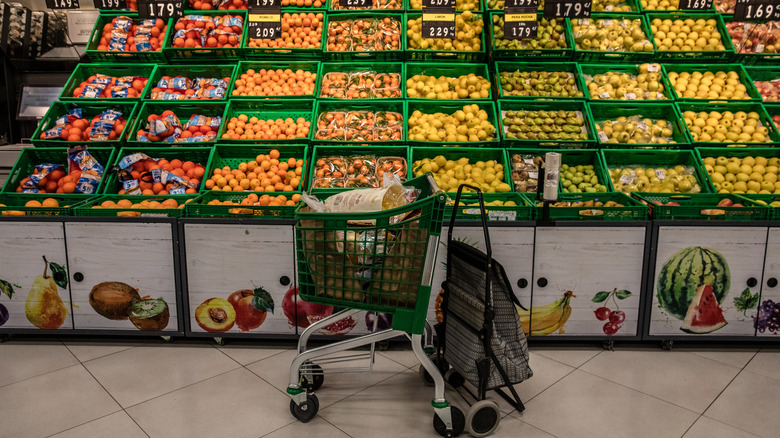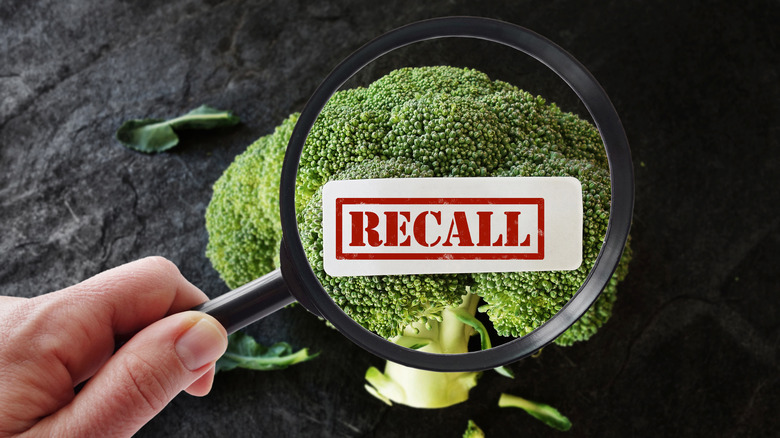New Report Reveals How Long It Takes For Food To Be Recalled
This month, many brands affiliated with peanut butter giant Jif saw a massive recall over a salmonella outbreak. But instead of horror, caution, or even surprise, many consumers might be feeling desensitized to news of mass food contamination, as it seems to happen fairly often. (No, you're not imagining it: Time reported in 2019 that, due to a variety of factors such as improved detection mechanisms and companies erring further on the side of caution, food recalls in the U.S. have increased.)
The phrase "foodborne illness" might call food poisoning to mind — for most, a fairly routine, although highly unpleasant condition. (According to the CDC, one in six people living in the U.S. contract food poisoning every year.) But foodborne illnesses are nothing to take lightly. In its guidelines on food safety, the CDC estimates that, of those 48 million foodborne illness cases, 3,000 prove to be fatal.
The early-2022 mass listeria outbreak that caused 16 hospitalizations and three deaths across 13 states was traced to contaminated lettuce in Dole packaged salads, reports Food Safety News. Last year, an import of onions from Chihuahua, Mexico contaminated with salmonella infected 1,040 people across 39 states, the District of Columbia, and Puerto Rico (via CDC).
So, for as common as these serious outbreaks seem to be, why haven't more measures been taken to prevent them from happening on such a massive scale? A new study by public interest advocate group US PIRG explores how long it takes for food to be officially recalled in the U.S. — and why.
Food retailers and the FDA are operating on different timelines
Currently, all that is required to notify the public of a recall is for the company issuing the recall to publish a news release and to make a post about it on the FDA website. Per US PIRG, many grocers are actually informed of recalls by their suppliers, rather than the FDA. The report states that this often even happens before the notice is published by the government body.
US PIRG interviewed 50 of the largest grocery retailers in the U.S. and asked how and when they notify shoppers about food recalls. Half of the retailers said they notify customers via text alert, email, or phone call within 24 hours of learning about the recall. To reach customers, they pull their contact information from loyalty cards or purchase data. ⅓ of the retailers said they immediately post news of recalls on their website or social media accounts.
By contrast, per US PIRG, the FDA can take up to a week to issue a public announcement. The report suggests this delayed communication can have serious, even deadly, ramifications.
US PRIG's report has a potential solution
2011's Food Safety Modernization Act requires grocery stores with 15 or more locations to "prominently display" recall notices within a day of the FDA's announcement. However, US PIRG says since the FDA has not released specific guidelines as to what exactly constitutes a "prominent display," stores are technically not required to abide by the Act. This also raises the question of whether it's really the responsibility of grocery stores to alert the public about recalls, the companies themselves, or the government.
Mass food supply contaminations happen relatively frequently, and the report asserts the safeguards in place to prevent or recover from these events are lacking. In an interview with the public interest advocate group, Dr. Ben Chapman, professor and food safety scientist at North Carolina State University, wonders why a more efficient food recall system isn't already in place. "I have no idea why it takes that long. It's a black box," he stated, positing that a more centralized system might be able to communicate food recalls more quickly and efficiently across greater distances, which could be particularly helpful in mass salmonella or listeria outbreaks. "We have an inconsistent, fragmented system," says Chapman. "No one really owns recall."


